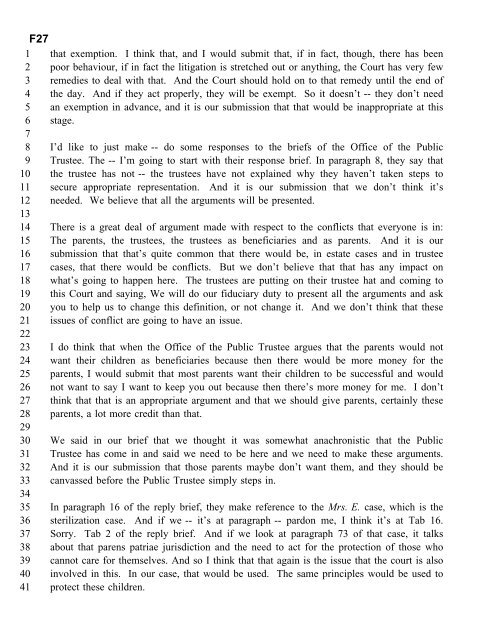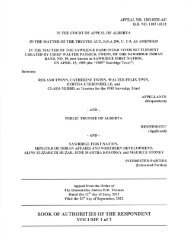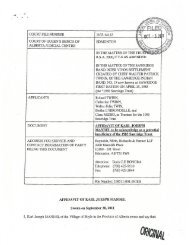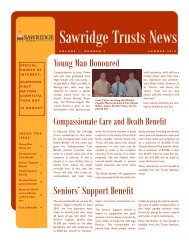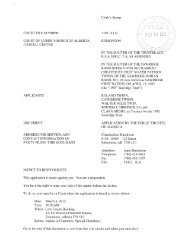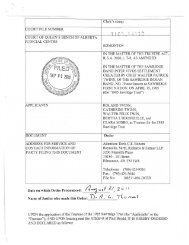31420-12-1 SAWRIDGE, Indian vs. ROLAND, Twinn et al
31420-12-1 SAWRIDGE, Indian vs. ROLAND, Twinn et al
31420-12-1 SAWRIDGE, Indian vs. ROLAND, Twinn et al
Create successful ePaper yourself
Turn your PDF publications into a flip-book with our unique Google optimized e-Paper software.
F27<br />
1 that exemption. Ithink that, and I would submit that, if in fact, though, there has been<br />
2 poor behaviour, if in fact the litigation is str<strong>et</strong>ched out or anything, the Court has very few<br />
3 remedies to de<strong>al</strong> with that. And the Court should hold on to that remedy until the end of<br />
4 the day. And if they act properly, they will be exempt. So it doesn’t -- they don’t need<br />
5 anexemption in advance, and it is our submission that that would be inappropriate at this<br />
6<br />
7<br />
stage.<br />
8 I’d like to just make -- do some responses to the briefs of the Office of the Public<br />
9 Trustee. The -- I’m going to start with their response brief. In paragraph 8, they say that<br />
10 the trustee has not -- the trustees have not explained why they haven’t taken steps to<br />
11 secure appropriate representation. And it is our submission that we don’t think it’s<br />
<strong>12</strong><br />
13<br />
needed. We believe that <strong>al</strong>l the arguments will be presented.<br />
14 There is a great de<strong>al</strong> of argument made with respect to the conflicts that everyone is in:<br />
15 The parents, the trustees, the trustees as beneficiaries and as parents. And it is our<br />
16 submission that that’s quite common that there would be, in estate cases and in trustee<br />
17 cases, that there would be conflicts. But we don’t believe that that has any impact on<br />
18 what’s going to happen here. The trustees are putting on their trustee hat and coming to<br />
19 this Court and saying, We will do our fiduciary duty to present <strong>al</strong>l the arguments and ask<br />
20 you to help us to change this definition, or not change it. And we don’t think that these<br />
21<br />
22<br />
issues of conflict are going to have an issue.<br />
23 I do think that when the Office of the Public Trustee argues that the parents would not<br />
24 want their children as beneficiaries because then there would be more money for the<br />
25 parents, Iwould submit that most parents want their children to be successful and would<br />
26 not want to say I want to keep you out because then there’s more money for me. Idon’t<br />
27 think that that is an appropriate argument and that we should give parents, certainly these<br />
28<br />
29<br />
parents, <strong>al</strong>ot more credit than that.<br />
30 We said in our brief that we thought it was somewhat anachronistic that the Public<br />
31 Trustee has come in and said we need to be here and we need to make these arguments.<br />
32 And it is our submission that those parents maybe don’t want them, and they should be<br />
33<br />
34<br />
canvassed before the Public Trustee simply steps in.<br />
35 In paragraph 16 of the reply brief, they make reference to the Mrs. E. case, which is the<br />
36 sterilization case. And if we -- it’s at paragraph -- pardon me, I think it’s at Tab 16.<br />
37 Sorry. Tab 2 of the reply brief. And if we look at paragraph 73 of that case, it t<strong>al</strong>ks<br />
38 about that parens patriae jurisdiction and the need to act for the protection of those who<br />
39 cannot care for themselves. And so I think that that again is the issue that the court is <strong>al</strong>so<br />
40 involved in this. In our case, that would be used. The same principles would be used to<br />
41 protect these children.


